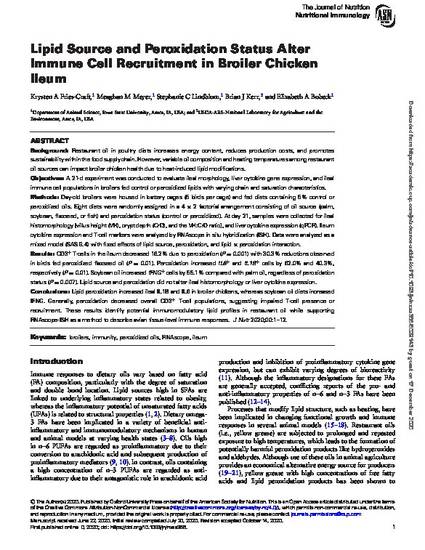
Background: Restaurant oil in poultry diets increases energy content, reduces production costs, and promotes sustainability within the food supply chain. However, variable oil composition and heating temperatures among restaurant oil sources can impact broiler chicken health due to heat-induced lipid modifications.
Objectives: A 21-d experiment was conducted to evaluate ileal morphology, liver cytokine gene expression, and ileal immune cell populations in broilers fed control or peroxidized lipids with varying chain and saturation characteristics.
Methods: Day-old broilers were housed in battery cages (5 birds per cage) and fed diets containing 5% control or peroxidized oils. Eight diets were randomly assigned in a 4 × 2 factorial arrangement consisting of oil source (palm, soybean, flaxseed, or fish) and peroxidation status (control or peroxidized). At day 21, samples were collected for ileal histomorphology [villus height (VH), crypt depth (CrD), and the VH:CrD ratio], and liver cytokine expression (qPCR). Ileum cytokine expression and T-cell markers were analyzed by RNAscope in situ hybridization (ISH). Data were analyzed as a mixed model (SAS 9.4) with fixed effects of lipid source, peroxidation, and lipid × peroxidation interaction.
Results: CD3+ T-cells in the ileum decreased 16.2% due to peroxidation (P = 0.001) with 30.3% reductions observed in birds fed peroxidized flaxseed oil (P = 0.01). Peroxidation increased IL6+ and IL1B+ cells by 62.0% and 40.3%, respectively (P = 0.01). Soybean oil increased IFNG+ cells by 55.1% compared with palm oil, regardless of peroxidation status (P = 0.007). Lipid source and peroxidation did not alter ileal histomorphology or liver cytokine expression.
Conclusions: Lipid peroxidation increased ileal IL1B and IL6 in broiler chickens, whereas soybean oil diets increased IFNG. Generally, peroxidation decreased overall CD3+ T-cell populations, suggesting impaired T-cell presence or recruitment. These results identify potential immunomodulatory lipid profiles in restaurant oil while supporting RNAscope-ISH as a method to describe avian tissue-level immune responses.
Available at: http://works.bepress.com/elizabeth-bobeck/23/

This article is published as Fries-Craft, Krysten A., Meaghan M. Meyer, Stephanie C. Lindblom, Brian J. Kerr, and Elizabeth A. Bobeck. "Lipid Source and Peroxidation Status Alter Immune Cell Recruitment in Broiler Chicken Ileum." The Journal of Nutrition (2020). doi: 10.1093/jn/nxaa356.